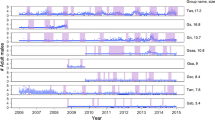Abstract
Successful or unsuccessful female transfers were observed seven times during a 32-month field study of proboscis monkeys (Nasalis larvatus) inhabiting a riverine forest along a tributary of the Kinabatangan River, Sabah, Malaysia. In all cases, the females voluntarily left their own groups and immediately joined with another one. When adult females tried to shift to other groups, adult males called them back to their own groups, but appeared to be indifferent to subadult females. When the adult females returned, the males never attacked the females physically, but instead often emitted herding sounds to them. One subadult female was repelled by a resident adult female. When one adult female transferred into a new one-male group, she left her behind son in an all-male group. The number of females often fluctuated in most study groups, with this fluctuation being more prominent among subadult females than adult females. It is likely that female transfer in proboscis monkeys is not a rare occurrence and that it is especially common among sub-adult females.

Similar content being viewed by others
References
Agoramoorthy G, Hsu MJ (2004) Occurrence of infanticide among wild proboscis monkeys (Nasalis larvatus) in Sabah, Northern Borneo. Folia Primatol 76:177–179
Ali R (1981) The ecology and social behaviour of the Agasyamalai bonnet macaque (Macaca radiata diuta). PhD thesis, University of Bristol, Bristol, UK
Bauchop P, Martucci RW (1968) Ruminant-like digestion of the langur monkey. Science 161:698–700
Bennett EL, Sebastian T (1988) Social organization and ecology of proboscis monkeys (Nasalis larvatus) in mixed coastal forest in Sarawak. Int J Primatol 9:233–256
Boonratana R (1999) Dispersal in proboscis monkeys (Nasalis larvatus) in the Lower Kinabatangan, Northern Borneo. Trop Biodivers 6:179–187
Boonratana R (2000) Ranging behavior of proboscis monkeys (Nasalis larvatus) in the Lower Kinabatangan, Northern Borneo. Int J Primatol 21:497–518
Boonratana R (2002) Social organisation of proboscis monkeys (Nasalis larvatus) in the Lower Kinabatangan, Sabah, Malaysia. Malays Nat J 56:57–75
Clutton-Brock TH (1988) Female transfer and inbreeding avoidance in social mammals. Nature 337:70–72
Crockett CM (1984) Emigration by female red howler monkeys and the case for female competition. In: Small MF (ed) Female primates: studies by women primatologists. Alan R Liss, New York, pp 159–173
Dunbar RIM, Dunbar EP (1975) Social dynamics of gelada baboons. Karger, Basel
Lehner PN (1979) Handbook of ethological methods. Garland Press, New York, pp 117–118
Moore J (1984) Female transfer in primates. Int J Primatol 5:537–589
Murai T (2004) Social behaviors of all-male proboscis monkeys when joined by females. Ecol Res 19:451–454
Napier JR, Napier PH (1985) The natural history of the primates. MIT Press, Cambridge
Oates JF, Davies AG (1994) What are the colobines? In: Davies AG, Oates JF (eds) Colobine monkeys: their ecology, behaviour and evolution. Cambridge University Press, Cambridge, pp 1–9
Pusey AE, Packer C (1987) Dispersal and philopatry. In: Smuts BB, Cheney DL, Seyfarth RM, Struhsaker TT, Wrangham RW (eds) Primate societies. University of Chicago Press, Chicago, pp 250–266
Rajanthan R, Bennett EL (1990) Note on the social behaviour of wild proboscis monkeys (Nasalis larvatus). Malays Nat J 44:35–44
Stammbach E (1987) Desert, forest and montane baboons: multilevel-societies. In: Smuts BB, Cheney DL, Seyfarth RM, Struhsaker TT, Wrangham RW (eds) Primate societies. University of Chicago Press, Chicago, pp 112–120
Stanford CB (1991) The capped langur in Bangladesh: behavioral ecology and reproductive tactics. Contributions to primatology, vol 26. Karger, New York
Sterck EHM (1997) Determinants of female dispersal in Thomas langurs. Am J Primatol 42:179–198
Wrangham RW (1980) An ecological model of female-bonded primate groups. Behaviour 75:262–299
Yeager CP (1990) Proboscis monkey (Nasalis larvatus) social organization: group structure. Am J Primatol 20:95–106
Yeager CP (1991) Proboscis monkey (Nasalis larvatus) social organization: intergroup patterns of association. Am J Primatol 23:73–86
Yeager CP (1995) Does intraspecific variation in social systems explain reported differences in the social structure of the proboscis monkey (Nasalis larvatus)? Primates 36:575–582
Acknowledgements
We would like to express our sincere thanks to Dr. K. Watanabe for his valuable advice in preparing this manuscript, and to Dr. M. Mitani for his encouragement and field support. Cordial thanks are also due to staff members of the Kota Kinabatangan Wildlife Department for their help in the fieldwork, and to Ms. T. Murai for her field assistance throughout the study. We also thank anonymous reviewers for their valuable comments on this manuscript.
Author information
Authors and Affiliations
Corresponding author
About this article
Cite this article
Murai, T., Mohamed, M., Bernard, H. et al. Female transfer between one-male groups of proboscis monkey (Nasalis larvatus). Primates 48, 117–121 (2007). https://doi.org/10.1007/s10329-006-0005-2
Received:
Accepted:
Published:
Issue Date:
DOI: https://doi.org/10.1007/s10329-006-0005-2




